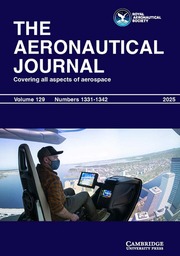Article contents
Comparison of numerical and experimentaldrag measurement in hypervelocityflow
Published online by Cambridge University Press: 04 July 2016
Extract
In planning interplanetary missions which involve anaerobraking manoeuvre, it is necessary to makeaccurate predictions of the aerodynamic drag actingon a vehicle during its descent. Of interest to theauthors is the Nasa initiative for exploration ofMars and its atmosphere. The Mars Pathfinder is aprobe that is expected to enter the Martianatmosphere at a relative velocity of approximately7.6 kms-1;. The forebody of this vehicleis based on a 70° blunted cone and is typical ofaerobraking designs.
In this note, a comparison is made between experimentaland numerical techniques for predicting drag inhypervelocity flow. Three different models wereexamined in this study: a 30° sharp cone; an Apolloheat shield; and a Viking heat shield. A relativelysimple analytical result for the drag on a coneprovides a convenient reference for both theexperimental and numerical results. The two heatshields are typical of those used for interplanetaryexploration, such as the Mars Pathfinder. Our aim isto give an example of how computational fluiddynamics can be used in conjunction with experimentsto obtain information about the hypervelocity flowabout re-entry vehicles.
Information
- Type
- Technical Note
- Information
- Copyright
- Copyright © Royal Aeronautical Society 1996
References
- 1
- Cited by

